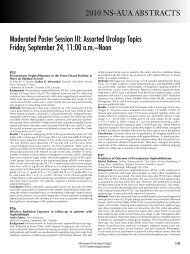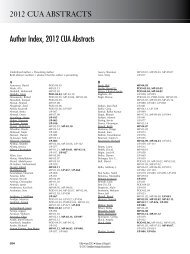Detrusor underactivity is prevalent after radical prostatectomy: a ...
Detrusor underactivity is prevalent after radical prostatectomy: a ...
Detrusor underactivity is prevalent after radical prostatectomy: a ...
You also want an ePaper? Increase the reach of your titles
YUMPU automatically turns print PDFs into web optimized ePapers that Google loves.
Early release. Publ<strong>is</strong>hed at www.cuaj.ca on January 24, 2012. Subject to rev<strong>is</strong>ion.<br />
Cite as: Can Urol Assoc J 2012. http://dx.doi.org/10.5489/cuaj.11038. Epub 24 Jan 2012.<br />
Abstract<br />
Introduction: The objective was to determine the prevalence of,<br />
and factors that predict, detrusor <strong>underactivity</strong> (DU) in patients<br />
presenting with incontinence or lower urinary tract symptoms<br />
(LUTS) following <strong>radical</strong> <strong>prostatectomy</strong> (RP). We also determined<br />
the prevalence of bladder outlet obstruction (BOO) and detrusor<br />
overactivity (DO) in th<strong>is</strong> population.<br />
Methods: Patients who underwent urodynamics post-RP were<br />
identified. <strong>Detrusor</strong> <strong>underactivity</strong> was defined as a maximum<br />
flow rate (Qmax) of ≤15 mL/s and detrusor pressure (Pdet) Qmax<br />
chung et al.<br />
tinence or lower urinary tract symptoms (LUTS) following<br />
RP. We also determined the prevalence of bladder outlet<br />
obstruction (BOO) and detrusor overactivity (DO) in th<strong>is</strong><br />
population.<br />
Methods<br />
Th<strong>is</strong> study included data on 264 patients with UI or LUTS<br />
post-RP. After institutional review board approval, patients<br />
who had undergone RP and video-urodynamic studies<br />
between August 2005 and December 2008 were identified.<br />
All patients were evaluated with detailed h<strong>is</strong>tory, physical<br />
examination, urodynamics and cystoscopy. Incontinence<br />
was defined as involuntary leakage of any amount of urine<br />
requiring protection. For patients who had surgery at our<br />
institution, additional prostate cancer and follow-up data<br />
were obtained. We identified 307 urodynamic studies.<br />
Studies on patients with AUS and duplicate studies on a<br />
single patient were excluded (n = 26).<br />
Prior to urodynamics, free uroflow data were obtained<br />
and all patients d<strong>is</strong>continued antimuscarinics for ≥1 week.<br />
Post-void residual urine (PVR) was measured by catheterization.<br />
Urodynamics testing was conducted according to<br />
ICS guidelines using Laborie (Toronto, ON) equipment. At<br />
200 mL, patients coughed and performed valsalva to record<br />
valsalva leak point pressure (VLPP). These maneuvers were<br />
repeated at capacity. We defined PdetQmax as detrusor<br />
pressure at time of Qmax. Bladder outlet obstruction was<br />
determined by Abrams-Griffiths nomogram. Criterion for AV<br />
was sustained increase in abdominal pressure during voiding.<br />
After voiding, the bladder was refilled to 200 mL, the<br />
catheter was removed and VLPPs were repeated. Abdominal<br />
pressure was used to record VLPP (as opposed to ICS guidelines)<br />
to allow the recording of VLPP without a catheter in<br />
place. Th<strong>is</strong> <strong>is</strong> often necessary to document VLPP in patients<br />
with anastomotic strictures (AS) and UI. Fluoroscopic images<br />
were obtained throughout. After urodynamics, all patients<br />
underwent flexible (14 Fr) cystoscopy. The presence of AS,<br />
AV and DO was recorded.<br />
The criteria for DU were Qmax ≤15 mL/sec and PdetQmax<br />
≤20 cm H20. For patients unable to void, the criterion was<br />
maximum Pdet ≤20 cm H20 during attempted voiding.<br />
To determine which factors were predictive of DU, we<br />
used log<strong>is</strong>tic regression. Factors examined were age at <strong>prostatectomy</strong>,<br />
year of <strong>prostatectomy</strong>, procedure type (minimally-invasive<br />
surgery [MIS] vs. open RP), nerve-sparing status<br />
(none, unilateral, bilateral), clinical stage (≤T2A and ≥T2B),<br />
biopsy Gleason grade (7), postoperative radiation<br />
and time between <strong>prostatectomy</strong> and first clinic v<strong>is</strong>it.<br />
We tested for differences in the rates of incontinence and<br />
AS by detrusor activity using F<strong>is</strong>her’s exact test. Sensitivity<br />
analyses were conducted in the subgroup that had <strong>prostatectomy</strong><br />
at our institution. Stat<strong>is</strong>tical analyses were performed<br />
using Stata software 10.0 (Stata Corp., College Station, TX).<br />
2<br />
Can Urol Assoc J<br />
Early release. Publ<strong>is</strong>hed at www.cuaj.ca on January 24, 2012. Subject to rev<strong>is</strong>ion.<br />
The p values
sling placement. 5 One reason th<strong>is</strong> topic has not been studied<br />
extensively <strong>is</strong> that some urolog<strong>is</strong>ts are reluctant to place a<br />
sling in patients with DU for fear of causing urinary retention.<br />
Slings are designed to prevent incontinence during<br />
times of abdominal stress, a situation which ex<strong>is</strong>ts during AV.<br />
There <strong>is</strong> evidence of th<strong>is</strong> phenomenon in the female<br />
incontinence literature. In women, lower preoperative<br />
Qmax, which <strong>is</strong> associated with DU, <strong>is</strong> predictive of urinary<br />
retention following placement of a transvaginal tape (TVT)<br />
for stress UI. 13,14 Furthermore, female patients who experience<br />
retention following an incontinence procedure report<br />
lower sat<strong>is</strong>faction. 13<br />
Hong and colleagues conducted a multivariate analys<strong>is</strong><br />
to determine the r<strong>is</strong>k factors for postoperative retention<br />
in 375 women who underwent TVT. 13 Preoperative Qmax<br />
(p = 0.007) was the only factor predictive of retention. Miller<br />
and colleagues reviewed records of 98 women who had<br />
undergone pubovaginal sling to determine which urodynamic<br />
parameters best predicted postoperative voiding dysfunction.<br />
15 Urinary retention developed in 23% of women<br />
who voided with a Pdet
chung et al.<br />
Table 2. Univariate and multivariable log<strong>is</strong>tic regression for variables associated with detrusor <strong>underactivity</strong><br />
Predictor Univariate model Multivariate model<br />
OR 95% CI p OR 95% CI p<br />
Age at RP, year 1.01 0.97, 1.05 0.6 1.02 0.97, 1.07 0.5<br />
Pre-RP PSA, ng/mL (n=209) 0.99 0.97, 1.01 0.5 0.99 0.95, 1.03 0.6<br />
Type of surgery (laparoscopic/<br />
robotic vs. open) (n=264)<br />
2.05 1.20, 3.49 0.009 2.02 0.92, 4.44 0.08<br />
Year of RP, year (n=258) 1.04 0.99, 1.10 0.16 1.12 0.80, 1.55 0.5<br />
Clinical stage (≤T2A vs ≥T2B)<br />
(n=202)<br />
1.45 0.76, 2.78 0.3 2.27 0.86, 5.97 0.10<br />
Nerve sparing status (n=185) 0.9 0.8<br />
No Nerves Spared reference reference reference reference<br />
Unilaterally Spared 0.88 0.30, 2.55 0.83 0.32, 2.15<br />
Bilaterally Spared 0.86 0.42, 1.77 0.71 0.23, 2.14<br />
Biopsy Gleason grade (n=215) 0.5 0.24<br />
=8<br />
Time between RP and UDS<br />
0.60 0.24, 1.49 0.32 0.08, 1.39<br />
evaluation, per every 6 months<br />
(n=258)<br />
0.98 0.95, 1.01 0.13 1.05 0.88, 1.26 0.6<br />
Pelvic radiation (yes vs. no) (n=264) 0.77 0.41, 1.43 0.4 2.80 0.74, 10.6 0.13<br />
RP: <strong>radical</strong> <strong>prostatectomy</strong>; UDS: urodynamic studies; PSA: prostate-specific antigen.<br />
Similarly, rates of BOO in continent patients were higher<br />
(31% continent, 15% in incontinent). <strong>Detrusor</strong> <strong>underactivity</strong><br />
may actually be related to higher continence rates in post-<br />
RP patients because of potentially decreased rates of urge<br />
incontinence in th<strong>is</strong> group.<br />
While th<strong>is</strong> study does not directly address the impact of<br />
DU on efficacy of different treatments for incontinence post-<br />
RP, it does report a very high rate of DU and AV in patients<br />
who experienced LUTS or UI <strong>after</strong> contemporary RP. If, as<br />
our analys<strong>is</strong> implies, DU <strong>is</strong> higher in patients undergoing<br />
MIS, then the rate of DU following RP will continue to r<strong>is</strong>e<br />
because of increased adoption of MIS. Male slings might be<br />
susceptible to adverse outcomes in patients who void by AV.<br />
The limitations of th<strong>is</strong> study are its retrospective nature<br />
and select patient population, a limitation of most urodynamic<br />
studies in post-RP patients. Th<strong>is</strong> has to do with the fact<br />
that it <strong>is</strong> difficult and potentially cost-prohibitive to evaluate<br />
asymptomatic patients with urodynamics following RP in<br />
routine clinical practice. Comorbidity that may affect DU<br />
was not examined in th<strong>is</strong> study. However, for most d<strong>is</strong>ease<br />
states the relationship with detrusor contractility <strong>is</strong> unclear.<br />
4<br />
Can Urol Assoc J<br />
Early release. Publ<strong>is</strong>hed at www.cuaj.ca on January 24, 2012. Subject to rev<strong>is</strong>ion.<br />
For example, Kaplan and colleagues examined the urodynamics<br />
findings in 182 patients with diabetes. 25 The most<br />
common diagnoses were detrusor instability and BOO, not<br />
the classic “diabetic cystopathy.” Since DU and AV were<br />
part of our selection criteria for patients undergoing antiincontinence<br />
surgery, we could not determine the effect of<br />
DU or AV on procedure outcomes. Further studies of the efficacy<br />
of different anti-incontinence surgeries in patients with<br />
DU are warranted. Finally, our definition of DU <strong>is</strong> arbitrary;<br />
however, it should be noted that th<strong>is</strong> definition <strong>is</strong> easy to<br />
apply in a clinical setting, <strong>is</strong> similar to those used in studies<br />
with similar patient population, 2,4 and <strong>is</strong> very conservative,<br />
corresponding to bladder contractility index (BCI)
incontinence treatment, particularly with the male sling, it<br />
<strong>is</strong> useful to document its presence prior to treatment. More<br />
studies are needed to elucidate the influence of DU on surgical<br />
treatment for male UI <strong>after</strong> RP. Moreover, our findings<br />
need to be replicated in a community-based setting.<br />
Competing interests: None declared.<br />
Th<strong>is</strong> paper has been peer-reviewed.<br />
References<br />
1. Hammerer P, Huland H. Urodynamic evaluation of changes in urinary control <strong>after</strong> <strong>radical</strong> retropubic<br />
<strong>prostatectomy</strong>. J Urol 1997;157:233-6. http://dx.doi.org/10.1016/S0022-5347(01)65334-5<br />
2. Kielb S, Clemens J. Comprehensive urodynamics evaluation of 146 men with incontinence <strong>after</strong> <strong>radical</strong><br />
<strong>prostatectomy</strong>. Urology 2005;66:392-6. http://dx.doi.org/10.1016/j.urology.2005.03.026<br />
3. Chao R, Mayo M. Incontinence <strong>after</strong> <strong>radical</strong> <strong>prostatectomy</strong>: detrusor or sphincter causes. J Urol<br />
1995;154:16-8. http://dx.doi.org/10.1016/S0022-5347(01)67212-4<br />
4. Groutz A, Blaivas J, Chaikin D, et al. The pathophysiology of post-<strong>radical</strong> <strong>prostatectomy</strong> incontinence: a<br />
clinical and video urodynamic study. J Urol 2000;163:1767-70. http://dx.doi.org/10.1016/S0022-<br />
5347(05)67538-6<br />
5. Comiter C. Surgery Insight: surgical management of post<strong>prostatectomy</strong> incontinence--the artificial urinary<br />
sphincter and male sling. Nat Clin Pract Urol 2007;4:615-24. http://dx.doi.org/10.1038/ncpuro0935<br />
6. Abrams P, Cardozo L, Fall M, et al; Standard<strong>is</strong>ation Sub-committee of the International Continence.<br />
The standard<strong>is</strong>ation of terminology of lower urinary tract function: report from the Standard<strong>is</strong>ation Subcommittee<br />
of the International Continence Society. Society Neurourol Urodyn 2002;21:167-78. http://<br />
dx.doi.org/10.1002/nau.10052<br />
7. Cucchi A, Quaglini S, Rovereto B. Proposal for a urodynamic redefinition of detrusor <strong>underactivity</strong>. J Urol<br />
2007;181:225-9. http://dx.doi.org/10.1016/j.juro.2008.09.018<br />
8. Giannantoni A, Mearini E, Zucchi A, et al. Bladder and urethral sphincter function <strong>after</strong> <strong>radical</strong> retropubic<br />
<strong>prostatectomy</strong>: a prospective long-term study. Eur Urol 2008;54:657-64. http://dx.doi.org/10.1016/j.<br />
eururo.2007.10.054<br />
9. Maffezzini M, Seveso M, Taverna G, et al. Evaluation of complications and results in a contemporary series<br />
of 300 consecutive <strong>radical</strong> retropubic prostatectomies with the anatomic approach at a single institution.<br />
Urology 2003;61:982-6. http://dx.doi.org/10.1016/S0090-4295(02)02517-7<br />
10. Penson D, McLerran D, Feng Z, et al. 5-year urinary and sexual outcomes <strong>after</strong> <strong>radical</strong> <strong>prostatectomy</strong>: results<br />
from the Prostate Cancer Outcomes Study. J Urol 2008;179:S40-4. http://dx.doi.org/10.1016/j.<br />
juro.2008.03.136<br />
Can Urol Assoc J<br />
Early release. Publ<strong>is</strong>hed at www.cuaj.ca on January 24, 2012. Subject to rev<strong>is</strong>ion.<br />
Urodynamics <strong>after</strong> <strong>radical</strong> <strong>prostatectomy</strong><br />
11. Ullrich N, Comiter C. The male sling for stress urinary incontinence: urodynamic and subjective assessment.<br />
J Urol 2004;172:204-6. http://dx.doi.org/10.1097/01.ju.0000132146.79081.da<br />
12. Davies T, Bepple J, McCammon K. Urodynamic changes and initial results of the AdVance male sling.<br />
Urology 2009;74:354-7. http://dx.doi.org/10.1016/j.urology.2008.12.082<br />
13. Hong B, Park S, Kim H, et al. Factors predictive of urinary retention <strong>after</strong> a tension-free vaginal tape<br />
procedure for female stress urinary incontinence. J Urol 2003;179:852-6. http://dx.doi.org/10.1007/<br />
s00240-003-0378-2<br />
14. Kawashima H, Hirai K, Okada N, et al. The importance of studying pressure-flow for predicting postoperative<br />
voiding difficulties in women with stress urinary incontinence: a preliminary study that correlates low Pdet<br />
x Qave with postoperative residual urine. Urol Res 2004;32:84-8.<br />
15. Miller E, Amundsen C, Toh K, et al. Preoperative urodynamic evaluation may predict voiding dysfunction<br />
in women undergoing pubovaginal sling. J Urol 2003;169:2234-7. http://dx.doi.org/10.1097/01.<br />
ju.0000063590.13100.4d<br />
16. Gomha M, Boone T. Voiding patterns in patients with post-<strong>prostatectomy</strong> incontinence: urodynamic and<br />
demographic analys<strong>is</strong>. J Urol 2003;169:1766-9.<br />
17. Lai H, Hsu E, Teh B, et al. 13 years of experience with artificial urinary sphincter implantation at Baylor<br />
College of Medicine. J Urol 2007;177:1021-5. http://dx.doi.org/10.1016/j.juro.2006.10.062<br />
18. Lai H, Hsu E, Boone T. Urodynamic testing in evaluation of post<strong>radical</strong> <strong>prostatectomy</strong> incontinence before<br />
artificial urinary sphincter implantation. Urology 2009;73:1264-9. http://dx.doi.org/10.1016/j.urology.2008.10.037<br />
19. Lipski B, Mitchell M, Burns M. Voiding dysfunction <strong>after</strong> bilateral extravesical ureteral reimplantation. J<br />
Urol 1998;159:1019. http://dx.doi.org/10.1016/S0022-5347(01)63826-6<br />
20. Portillo F, Seif C, Braun P, et al. R<strong>is</strong>k of detrusor denervation in antireflux surgery demonstrated in<br />
a neurophysiological animal model. J Urol 2003;170:570-4. http://dx.doi.org/10.1097/01.<br />
ju.0000077446.49441.a9<br />
21. Walsh P. Anatomic <strong>radical</strong> <strong>prostatectomy</strong>: evolution of the surgical technique. J Urol 1998;160(6 Pt<br />
2):2418-24. http://dx.doi.org/10.1016/S0022-5347(01)62202-X<br />
22. Hollabaugh Jr R, Dmochowski R, Kneib T, et al. Preservation of putative continence nerves during <strong>radical</strong><br />
retropubic <strong>prostatectomy</strong> leads to more rapid return of urinary continence. J Urol 1998;51:960-7. http://<br />
dx.doi.org/10.1016/S0090-4295(98)00128-9<br />
23. Touijer K, Guillonneau B. Laparoscopic <strong>radical</strong> <strong>prostatectomy</strong>. Urol Oncol 2004;22:133-8. http://dx.doi.<br />
org/10.1016/j.urolonc.2004.01.005<br />
24. Hu J, Gu X, Lipsitz S, et al. Comparative effectiveness of minimally invasive vs open <strong>radical</strong> <strong>prostatectomy</strong>.<br />
JAMA 2009;302:1557-64. http://dx.doi.org/10.1001/jama.2009.1451<br />
25. Kaplan S, Te A, Blaivas J. Urodynamic findings in patients with diabetic cystopathy. J Urol 1995;153:342-4.<br />
http://dx.doi.org/10.1097/00005392-199502000-00013<br />
26. Abrams P. Bladder outlet obstruction index, bladder contractility index and bladder voiding efficiency: three<br />
simple indices to define bladder voiding function. BJU Int 1999;84:14-5. http://dx.doi.org/10.1046/<br />
j.1464-410x.1999.00121.x<br />
Correspondence: Dr. Jaspreet S. Sandhu, Department of Surgery/Urology, Memorial Sloan-Kettering<br />
Cancer Center, 1275 York Ave., New York, NY 10065; fax: 212-452-3323; sandhuj@mskcc.org<br />
5






